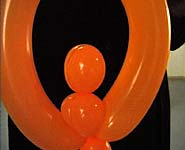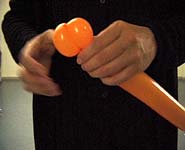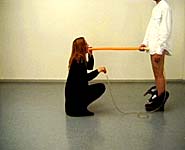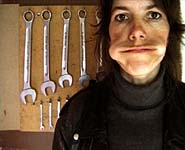|
AARHUS KUNSTMUSEUM
DEMO
|

|
|
Still from “Inflated Constructions”,
2000
|
INSTALLATION
Birgit Johnsen & Hanne Nielsen
17 June - 10 September 2000
demo 3/2000
©Aarhus Kunstmuseum and the artists
This catalogue has come forward in connection with the exhibition:
Hanne Nielsen & Birgit Johnsen
Inflated Constructions
Aarhus Kunstmuseum 17.6. - 10.10 2000
Curator: Anders Kold
Assistant: Lise Jakobsen
Installation: Hanne Nielsen, Birgit Johnsen, Kurt Hansen and Jørn Andersen
Translation: Ulrikka S. Gernes
Monkey wrenches, balloon animals and other ambiguous elements — Videos by Hanne Nielsen and Birgit Johnsen
By Sanne Kofod Olsen
Humor plays a central role in the video works by Hanne Nielsen and Birgit Johnsen; a humor which isn’t harmless but, on the contrary, teases the expectations in their ambiguity and unpredictability. Johnsen & Nielsen mimic aspects of reality which is always the central core in the videos. One could call this a postmodern parody which, to a certain degree, is also feminist. This approach squares its accounts with the gender stereotypes by mocking male and female roles and places a deliberately female subject in the central role as the narrator.
Since 1994 Johnsen & Nielsen, have been producing videos with gender roles as their thematic core. For example, there is the video entitled “Grating Onions” from 1995, in which two women are seen grating one onion after the other, while tears are lashing down their cheeks. An ironic commentary on the motto: “the woman’s place is in the home” but also on feminism, regarded on a more overall level, where the domestic role of the woman is frequently linked up with the pain of repression.
Another, and perhaps slightly more, undefined pain is at stake in the video entitled “Attributes” from 1997, where a man literally undresses a rabbit (he skins it) whereupon he dresses it again in baby clothes (or doll’s clothes). The rabbit, still wearing fur on its head and paws, is lying on something resembling a baby-changing table as it is being dressed with great caution and apparent care. The parallel with the care of an infant is obvious. Instead of playing on the familiarity and sweetness of the situation, Johnsen & Nielsen shift the situation into something precarious, even downright horrifying (unheimlich (1)). This “unheimlichkeit”(2) is projected over to the man, whose presence is not accidental, in as much as the undefineable pain is connected here to the male subject.
The postmodern parody
Parody is centrally placed in the work of Johnsen & Nielsen. It is being used as a device to undermine the expectations associated with the stereotypical. This takes place on two levels: partly purely technically (in the narration) in the course of the sequence (3) and partly in the story which is being told (the narrative). In the sequences, you are surprised by the course of the action, for example, in the sudden change of imagery in “Attributes” where the skinned rabbit is lying on a b
|

|
|
Still from “Inflated Constructions”,
2000
|
aby-changing table. It is not a matter of some specific surprise that we find in the narration, but rather, and in a far greater perspective, a breakdown of gender stereotypes and power relations between men and women. This is characteristic of works by Johnsen & Nielsen.
The notion of parody is a part of the postmodern critical discourse, which renders possible a critical content in the work of art. With Johnsen & Nielsen, the critical and deconstructive aspect can be seen in the parody of gender constructions and power relations between the sexes.
Since the 1980s, the postmodern parody has often been discussed. Either as a pastiche (which means an imitation), a kind of art that imitates the isms of the past and focuses uncritically on style, form and surface, or as a critical image which implies a critique of representation, i.e., the ideological content of the images or stories. The Canadian theoretician, Linda Hutcheon, writes about the critical use of parody: “Postmodern parody is both deconstructively critical and constructively creative, paradoxically making us aware of both the limits and the powers of representation”(4) (5)
The parody also manifests itself on an overall level in the videos. Very often, the videos are characterised by masculine forms of presentation, of a kind. The videos refer to areas of interest which are frequently said to be “typically” masculine. For example, porno movies, an interest in cars, tools, garages, and so forth.
|
(1)On this, see Gitte Ørskov Madsen: Med virkeligheden som indsats - Birgit Johnsen og Hanne Nielsen’s videoer, exhibition catalogue, Viborg Kunstforening, Brænderigården 21.8. - 26.9.1999.
(2) As it appears from the above text, this concept has been defined by Sigmund Freud as the precarious/horrible which lies beyond the tangible in the physical world. It can be paralleled with the “real” in the work of Jaques Lacan, or the “abject” in the work of Julia Kristeva, without having exactly the same meaning.
(3) Sequence is the designation for the short and continuous course of events in a video or in a film. A kind of section.
(4)Linda Hutcheon: The Politics of Postmodernism, Routledge; London 1989, p. 98.
(5)In the definition of postmodernism I lean up against Hal Foster’s definition of a “postmodernism of resistance” as opposed to a “postmodernism of reaction”. The former is the modernist critical postmodernism (a father-revolt with postmodernism, with such a revolt’s connections and influences of the “father”. On the other hand, the latter is a regressive postmodernism which looks behind modernism in order to find “original” values. See, Hal Foster’s definition in Hal Foster, ed.; The Anti-Aesthetic - Essays on Postmodern Culture, Bay Press: Washington 1983, p. xi-xii.
|
Inflated Constructions, 2000
The commentary on male and female roles and the way of formulating such problems can also be seen in the latest video installation, “Inflated Constructions”, where both the man and the woman are present.
I. A fully dressed woman is kneeling in front of a standing, fully dressed man, sporting a seemingly as erect (though not dressed) member, which turns out to be a dildo mounted with a pump. The woman puts her mouth on the member and starts to blow. Out grows a long balloon of the common kind. The woman releases the balloon from the crotch of the man, ties a knot and gets up. Holding the balloon in her hands, she moves towards the camera where she forms an animal out of the balloon. In the end, the animal “emits” a long groan.
II. A fully dressed woman does the same as in the previous scene, but instead of her tying a knot, the balloon explodes between the man’s legs.
III. A small extended flipbook shows the first scene when you flip through it very rapidly.
In the narrative’s (I and II) immediate reference to sex and/or pornography,
|

|
|
Still from “Inflated Constructions”,
2000
|
the first clash takes place in the production of meaning. The apparently “naughty” scenario is rather innocent, after all, because the pornographic reference operates through a symbolic use of items (the balloon) which contain a whole different value and meaning in everyday life. Neither the balloon animal nor the balloon itself are usually linked to any form of sexual meaning and neither of them possesses any form of gender or sexuality. Apart from its phallic shape, the balloon can be viewed as quite neutral in any context. In “Inflated Constructions”, it is nevertheless sexualised. It becomes a symbol of the man’s penis and thereby a phallus in the best Freudian sense. In psychoanalysis phallus is defined as the symbolic penis. It is not to be understood concretely, but it constitutes a kind of cardinal point in a symbolic frame of understanding, where the phallus constitutes something abstract in the construction of meaning revolving around sex and the world. Phallus is (according to psychoanalysis) something that men have and women want to have, something they downright strive for. Phallus does not merely signify sexual satisfaction but satisfaction as such, since phallus implies an ideological power. Jaques Lacan, Freud’s successor within psychoanalysis, goes as far as to claim that all meaning (which is being produced in the world) is centered around phallus. The symbolic phallus is the cardinal point in the patriarchy, which is a masculinely defined ideological construction of meaning (6). Feminist psychoanalytical theory from the 1970s criticised Lacan’s interpretation and his bestowal of privilege on phallus, and called this conception phallo-centrism (and phallo-gocentrism). The opinion was that it was exactly at this point that feminism had to intervene, in order to deconstruct the dominating position of the phallus (7).
|
(6)See, for example, Jaques Lacan; Four Fundamental Concepts of Psychoanalysis, 1973.
(7) See, for example, Luce Irigaray; This Sex Which is Not One. Cornell University Press 1985 (first edition in French, 1977)
|
In the works by Nielsen & Johnsen one can thus trace a feminist deconstructive intention in relation to the phallo-centrism. Not using the same dogmatic feminist language as in the 1970s, but through a humorous parody of the symbolic (and maybe cultural, historical and social) phallus. They point toward the power relations between man and woman and toward the man’s phallo-centric power as an “inflated construction” (cf. the title), which partly blows up (literally) and is partly transformed into a small balloon animal (a toy animal) in the woman’s hands (the woman’s power). If one were to realise this sexual-metaphorical comparison, to its full degree, the woman’s hands would then be equivalent with the woman’s symbolic sexuality, and also with the place (the logocentric emblem) where she assumes power. Both the man and the woman are placed here in outer positions. The man’s phallus/power is, at first, taken away from him (video I) whereupon it is blown up (video II). His phallo-centric power is parodied as a play and as a masking, since this is a matter of substitutions, in an ambiguous sense. First a dildo, then a balloon, which in itself has two different meanings: as it has already been shown, the balloon is the inflated phallus (the symbolic one) and is as such equivalent with the play (a
|

|
|
Still from “Carwash”,
1999
|
representation), while the dildo is actually the masking (the false penis) and not only shows the sex but also the meaning of the sex as a construction. The woman’s power, insofar as she deprives the man of his, is something else. She is presented in a kneeling humility, a position from where she tries to satisfy (here, once again, we can take refuge in the literal meaning) the man, in her ordinary female role. The female role, however, has been distorted into something comical. The sexual and cultural satisfaction (the power over both the real and the symbolic phallus) becomes a parody exemplified through a groaning balloon animal, in video I, while the woman’s attempt to please winds up in an exaggeration of her own sexual role, in video II, since the balloon blows up. She has, quite simply, overdone her attempt to satisfy the man.
Carwash, 1999
In the video and installation, “Carwash”, male and female roles have been turned upside down. At the carwash, you are undoubtedly situated inside a male world. But in the video, women are washing the cars. Maybe you can talk here about an “ironic feminisation of masculine representations” (8), where both the male and the female roles are reversed with respect to general notions. “Parodic appropriations” (9), of a kind, of daily life, where a rather common everyday situation becomes the starting point for a breakdown of common notions of male and female roles.
In the video, a “Carwash” is seen at a distance. Two women are standing by a car waiting for their turn to get into the carwash. The picture changes and you are right in the middle of the carwash, which is slowly starting up. The car is thoroughly scrubbed down with soap and water by the automatic machines, while the video camera records from inside the car. The physical presence of a person can be detected by the sense of someone holding the camera inside the car. The picture changes again and the car is being placed outside, one in a long row of other quite ordinary cars, lined up as if exhibited before an audience. From the same distance as in the first shot, you see the car with one of the two women or with both of them inside the car. A sign spelling out a man’s name is placed in the windshield.
The interplay between close up and far away is an element that can also be seen in “Inflated Constructions”. The long distance not only renders the viewer, but also the camera operator, a voyeur of a kind: the spectator who merely registers what is going on. The camera angle is always seen from a human point of view, so that the viewer can identify immediately with the camera operator and the situation. In “Inflated Constructions”, the identity of the viewer/camera operator is further accentuated by the intimacy of the situation, which is fractured in the ensuing moment, since the viewer is suddenly made a party to this intimacy in the close-up shot. In “Carwash”, the intimacy is limited to the distant view, which is rather neutral. It evokes associations with a surveillance camera which is supposed to register which cars drive into and out of the carwash. The surprise is all the more dramatic when you suddenly find yourself in the middle of the washing process as seen from inside the car. The same (false) intimacy which is being played at in “Inflated Constructions”, with the small animal groaning at the viewer, is also experienced here when you suddenly find yourself inside the carwash. The sexual associations do not fail to materialise as you see the foam spraying from the carwash. In the next moment the car drives away, fresh and shiny.
|
(8) Hutcheon; op. cit., p. 100.
(9) ibid, p. 100. Hutcheon uses these designations concerning different examples from the world of art and literature. The aforementioned refers to Angela Carter; Nights at the Circus, and in this connection, to works by Barbara Kruger and Silvia Kolbowski.
|
In many ways, the cars can be juxtaposed with the balloons in “Inflated Constructions”, as the symbolic phallus. They are all personified and “masculinised” through the name signs in the windshields. They become synonymous with men and with a male universe. This notion is, however, broken by the presence of the women in the cars. One could claim that the presence of the women in the “masculinised” car evinces the connection between the carwash and the masculine as a fiction. A cultural myth, which reserves certain actions for a certain sex (as does the grating of onions). This is where the parody sets in as a critical tool that attempts to deconstruct the stereotypical notions of the masculine and the feminine and the fact that certain domains belong to certain sexes.
|

|
|
Still from “A monkey wrench and
other tools”,
1999
|
The parody on the gender determination of the carwash is not portrayed without an ironical distance. Love is expressed for the car which is being buffed and polished. It is being cared for in the same way one would for a small child (the female phallus, according to Lacanian psychoanalysis) and is obviously fetishised. Car fetishism is usually perceived as masculine. Not unlike Freud’s shoe-fetishism, where the man imagines the inside of the shoe being the female sexual organ. Car fetishism is more neutralised, but its metaphorical meaning is obvious: the car is being identified with a woman (in many languages, the car is referred to as “she”). It is the man’s object of pride which is being shown off on special occasions. This gender specification is exactly what is being undermined in the works by Johnsen & Nielsen. The balloon blows up when they get into the car.
A monkey wrench and other tools, 1999
The last video work to be discussed here is “A monkey wrench and other tools”, from 1999. Here we see a woman standing next to a set of monkey wrenches hanging on a rack of tools. The monkey wrenches are hanging in a row, neatly ordered according to sizes, the smallest one first and the largest last. The woman puts the first, and smallest, monkey wrench into her mouth, crosswise, with the result that her cheeks are bulging out on both sides. Then she puts the next monkey wrench into her mouth in the same way, and then the next and then the next again until she cannot keep the monkey wrench in her mouth anymore due to its size. Instead, she just puts the head of the monkey wrench into her mouth and she continues in this manner until she comes to the largest monkey wrench, which can be expanded to fit the nut. She opens this monkey wrench to its maximum width.
In a rather unambiguous way, the workshop is traditionally seen as masculine territory. The shape of the monkey wrenches are, in a symbolic way, rather unambiguous, as well. As in “Inflated Constructions”, the woman is striving for her phallus, which she obtains in a rather silly manner. The irony or the parody of performing (on the man’s premises?) is clear and simple here. It is a self-ironical image which is being given by the woman, which does not so much deconstruct gender specific roles as much as it mimics the endeavour of this deconstruction. What we see here is not meant to tell us that we cannot and should not do this. The message, rather, seems to be that there must be limits to the folly.
The video works by Johnsen & Nielsen point toward and relate to a reality in its rather overall appearance, as a commentary, perhaps a philosophising, on contemporary life and gender power relations. The English art critic, Victor Burgin, has written about the postmodern work: “modernist pretentions to artistic independence have further been subverted by the demonstration of the necessarily “intertextual” nature of the production of meaning; we can no longer unproblematically assume that “Art” is somehow “outside” of the complex of other representational practices and institutions with which it is contemporary ...”(10) In their relating to gender constructions and reality this can easily be said to be applicable to the works by Johnsen & Nielsen.
|
(10)Victor Burgin; The End of Art Theory - Criticism and Postmodernity, MacMillan: London 1986, p. 204.
|
|






